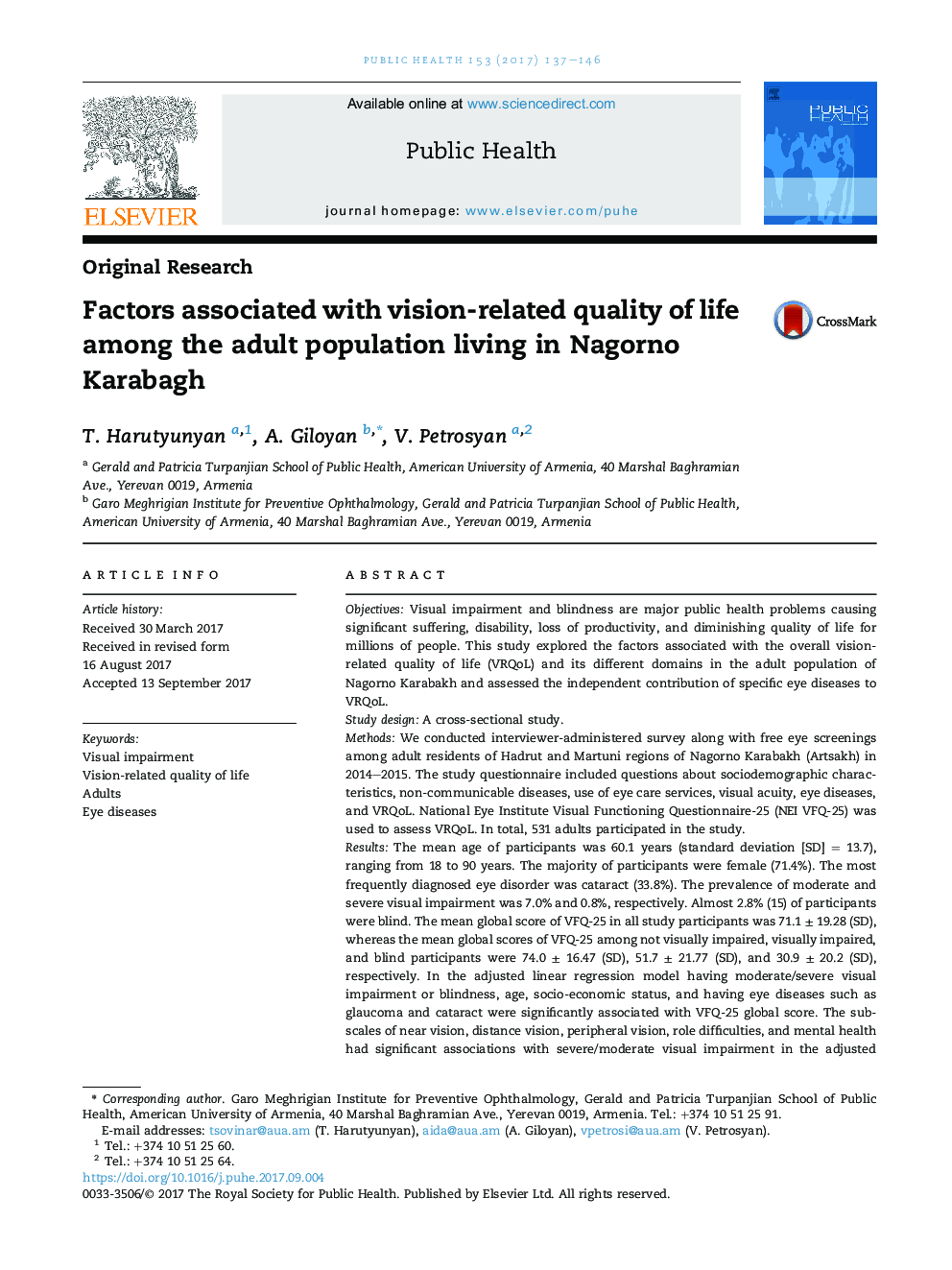| کد مقاله | کد نشریه | سال انتشار | مقاله انگلیسی | نسخه تمام متن |
|---|---|---|---|---|
| 5122657 | 1487190 | 2017 | 10 صفحه PDF | دانلود رایگان |
- Almost 7.8% of adults in Nagorno Karabagh were visually impaired.
- Visual impairment substantially reduced vision-related quality of life (VRQoL).
- VRQoL was significantly associated with age and socio-economic status.
- Cataract and glaucoma independently contributed to VRQoL.
ObjectivesVisual impairment and blindness are major public health problems causing significant suffering, disability, loss of productivity, and diminishing quality of life for millions of people. This study explored the factors associated with the overall vision-related quality of life (VRQoL) and its different domains in the adult population of Nagorno Karabakh and assessed the independent contribution of specific eye diseases to VRQoL.Study designA cross-sectional study.MethodsWe conducted interviewer-administered survey along with free eye screenings among adult residents of Hadrut and Martuni regions of Nagorno Karabakh (Artsakh) in 2014-2015. The study questionnaire included questions about sociodemographic characteristics, non-communicable diseases, use of eye care services, visual acuity, eye diseases, and VRQoL. National Eye Institute Visual Functioning Questionnaire-25 (NEI VFQ-25) was used to assess VRQoL. In total, 531 adults participated in the study.ResultsThe mean age of participants was 60.1 years (standard deviation [SD] = 13.7), ranging from 18 to 90 years. The majority of participants were female (71.4%). The most frequently diagnosed eye disorder was cataract (33.8%). The prevalence of moderate and severe visual impairment was 7.0% and 0.8%, respectively. Almost 2.8% (15) of participants were blind. The mean global score of VFQ-25 in all study participants was 71.1 ± 19.28 (SD), whereas the mean global scores of VFQ-25 among not visually impaired, visually impaired, and blind participants were 74.0 ± 16.47 (SD), 51.7 ± 21.77 (SD), and 30.9 ± 20.2 (SD), respectively. In the adjusted linear regression model having moderate/severe visual impairment or blindness, age, socio-economic status, and having eye diseases such as glaucoma and cataract were significantly associated with VFQ-25 global score. The subscales of near vision, distance vision, peripheral vision, role difficulties, and mental health had significant associations with severe/moderate visual impairment in the adjusted analysis. After adjusting for visual impairment and demographic variables, participants with cataract and glaucoma were found to have statistically significant lower subscale scores than those without eye disease.ConclusionOur data suggest that visual impairment was associated with lower scores of VRQoL. The strength of that association correlated with the increase in the level of visual impairment (from moderate/severe impairment to blindness). VRQoL was also shown to be affected by age, socio-economic status, and having eye diseases such as glaucoma and cataract. Further actions of remediation of visual impairment in this population are warranted.
Journal: Public Health - Volume 153, December 2017, Pages 137-146
